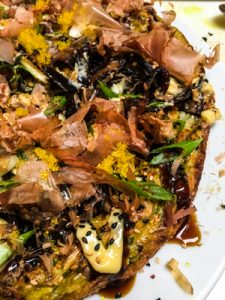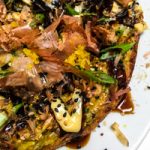Okonomiyaki
 I recently discovered something called a Savory Japanese Pancake, or Okonomiyaki on the menu of an Osaka-style restaurant. When it arrived at the table, I was instantly curious. As the waiter delivered this plate of art, ribbons of sauces interlaced across the top, and different colors and textures waited to be identified. Waving fins of smoke and dried tuna shavings danced atop the dish. Crispy on the outside and tender and fluffy on the inside, the first bite of what might be called a Japanese pizza was filled with thinly sliced vegetables and an incredible mix of stimulating and umami-rich flavors. I reached for my Japanese Rice Lager and loved how the hops in the Pilsner-style beer opened up the many different flavors I tasted. I thought about all of the ways this dish is a great example of beer cuisine.
I recently discovered something called a Savory Japanese Pancake, or Okonomiyaki on the menu of an Osaka-style restaurant. When it arrived at the table, I was instantly curious. As the waiter delivered this plate of art, ribbons of sauces interlaced across the top, and different colors and textures waited to be identified. Waving fins of smoke and dried tuna shavings danced atop the dish. Crispy on the outside and tender and fluffy on the inside, the first bite of what might be called a Japanese pizza was filled with thinly sliced vegetables and an incredible mix of stimulating and umami-rich flavors. I reached for my Japanese Rice Lager and loved how the hops in the Pilsner-style beer opened up the many different flavors I tasted. I thought about all of the ways this dish is a great example of beer cuisine.
One key Okonomiyaki ingredient that isn’t as common in most US grocery stores is yamaimo or Japanese mountain yam. This is a strange starch, similar in appearance to manioc and daikon, with a long shape and thick skin. Once cut into, the texture of this starchy root becomes gooey and slimy. Mixing it with flour, eggs, beer, and a Japanese-style broth called dashi, however, create a silky smooth texture with a fluffy, soufflé-like mouthfeel. I’ve included easy recipes for making tempura batter, dashi, and Okonomiyaki sauce to build this dish, which can be an entrée or a shareable course at a family meal or a beer dinner.
The beauty of the base recipe is that it offers an endless number of possible combinations for cooks who like to experiment. Typically the filling is made with vegetables, adding a supportive flavor and texture. Note that cabbage can call attention to dimethyl sulfide, or DMS, a flavor of cooked corn or green cabbage that is present in lagers. With all the umami-rich flavors as distractions, though, I still use it in this recipe. If you’re worried, other greens—kale, escarole, bok choy—can be substituted.
Serves: 6 – 8 guests
Adapted from BeerAdvocate Magazine: Cuisine à la Bière | Feb 2017 | Issue #121
- 3/4 cup flour, all-purpose
-
1/4 cup
cornstarch Sweet Potato Flour
or Tapioca Starch Powder
- 1/2 teaspoon baking powder
- 2 each eggs, extra large
- 1/4 cup dashi, cold, recipe HERE
- 1 teaspoon soy sauce | tamari | liquid aminos | shoyu
- 1 cup yamaimo, or Japanese mountain yam, grated - available at most Asian markets
- 1/2 cup Brown Ale, such as Big Sky Brewing Co. Moose Drool Brown Ale, Bells Best Brown Ale or other Brown Ale
- 2 tablespoon oil, vegetable or other neutral flavored oil
- 1/2 cup tenkasu tempura scraps, recipe HERE
- 2 cup Napa cabbage, cored and sliced thin
- 2 each green onions, or scallions, sliced thin on the bias
- 1 each carrot, peeled and coarse grated or julienned
- 2 tablespoon pickled red ginger, julienned
- 1 recipe Okonomiyaki Sauce recipe HERE
-
1/2 cup
White Miso Malt Vinegar Mayonnaise, recipe HERE or Kewpie Japanese Mayonnaise
- 2 each green onions, or scallions, sliced thin on the bias
- 2 tablespoon pickled red ginger, julienned
-
3 tablespoon
katsuobushi, Dried Bonito Flakes
(skipjack tuna) flakes
-
1 tablespoon
aonori dried seaweed powder
or (or julienned nori sheets)
- 2 tablespoon caviar, flavored tobiko such as yuzu, wasabi, or squid ink or Homemade Caviar Recipe
- 1 teaspoon sesame seeds, white toasted
- 1 teaspoon sesame seeds, black
- 1/2 teaspoon peppercorns, white, freshly cracked
- In a bowl, sift or whisk together the flour, starch, and baking powder. In another large bowl, whisk the eggs until very frothy, then add the Dashi and soy sauce | tamari | liquid aminos | shoyu. Peel the yamaimo and grate it on a medium to fine box grater. The texture will be slimy; this is normal. Add the grated yam to the egg mixture and whisk well to incorporate. Next, add the flour mixture to the egg mixture and mix to combine all the ingredients. Cover the bowl and refrigerate for at least an hour to relax any gluten that might have formed. While the pancake batter rests, prepare the remaining ingredients.
- Make the Tempura Batter and create the tenkasu. In another bowl, add the cored and finely sliced Napa cabbage, green onion, carrot, and pickled sushi ginger. After an hour, add the prepared vegetables to the pancake batter along with the ice-cold Brown Ale. Use your fingers to mix all the ingredients together well. This is also when other ingredients can be added to the batter. Try a quarter to a half pound of prepared calamari, shrimp, scallops, oysters, crabmeat, sliced smoked sausages, duck confit, shredded pork, etc.
- Okonomiyaki can be cooked a few different ways. Traditionally it’s prepared on a teppan or large iron griddle. I prefer a 6- to 8- inch nonstick sauté pan, as the sides of the savory pancake will also crisp up, creating more crust in the final product. Add the oil to a preheated pan over medium heat. Pour roughly a third of the batter to the hot pan, until it reaches about two-thirds up the sides. Lightly press the batter down, making sure the bottom of the pancake is in full contact with the hot surface. Eliminate any air pockets. Cook for 5 – 6 minutes or until a golden brown, crispy crust forms. Gently shake the pan or use a spatula to flip the pancake over. Lightly press it down again and cook an additional 5 – 7 minutes. Transfer to a cutting board or serving plate and repeat with the remaining batter.
- Once the pancake is done, it can be garnished much like a pizza. Add different toppings to create extra texture, pops of flavor, and visual appeal. First, use a squeeze bottle to drizzle ribbons of Okonomiyaki Sauce, or brush it on to make a sticky canvas for the rest of the ingredients. Drizzle the mayonnaise in a perpendicular pattern to the Okonomiyaki Sauce. Next, sprinkle the pancake with the green onion and pickled ginger. Then, evenly coat the top with bonito flakes, trying to keep them upright. Finish garnishing with the seaweed powder, caviar (if using), mixed sesame seeds, and a light dusting of white pepper. Serve.




